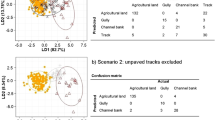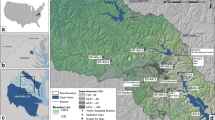Abstract
Purpose
The importance of bank erosion was quantified during three periods (October 2006–April 2007, May 2007–April 2008 and May 2008–April 2009) in the 486 km2 catchment area of River Odense, Denmark. A catchment sediment budget was established including other sediment sources such as tile drains and surface runoff, in-channel and overbank sinks and storage and the resulting bed load and suspended sediment load exported from the catchment.
Material and methods
Bank erosion and sedimentation were measured using ca. 3,000 erosion pins established in 180 pin plots, each consisting of three vertical lines of pins. Thirty-six representative reaches, each with a length of 100 m, were selected by a stratified random procedure in GIS. Bed load and suspended sediment export from the catchment were measured using a bed load sampler and from continuous measurements of turbidity at the outlet gauging station.
Results and discussion
The gross sediment input from bank erosion during the three study periods amounted to 21,100–25,200 t in the River Odense catchment, which is considerably higher than the estimated input of sediment from tile drains and surface runoff, which amounted to 220–500 t and 0–100 t, respectively. The measured bed load (20–490 t) was five to 60 times lower than the suspended sediment export from the catchment (1,240–2,620 t) during the three study periods, with the largest difference occurring in the driest year. Sediment sinks and storage were of high importance for the catchment sediment budget as the measured in-channel storage of sediment on stream banks was as high as 16,200–20,100 t, and the overbank sediment sink was estimated at 360–3,100 t.
Conclusions
Bank erosion was the dominant sediment source (90–94 %) in the River Odense catchment during the three study years. In-channel and overbank sediment sinks and storage dominated the sediment budget as 79–94 % of the sediment input from all sources was not exported from the catchment during the three study years. Such a large attenuation of sediment in river channels and on floodplains is extremely important for fluvial habitats and ecology. Moreover, it has strong implications for attempts to document changes in sediment export following implementation of mitigation measures.







Similar content being viewed by others
References
Collins AL, Anthony SG (2008) Assessing the likelihood of catchments across England and Wales meeting ‘good ecological status’ due to sediment contributions from agricultural sources. Environ Sci Policy 11:163–170
Collins AL, Walling DE (2007) Fine-grained bed sediment storage within the main channel systems of the Frome and Piddle catchments, Dorset, UK. Hydro Process 21:1448–1459
Collins AL, Walling DE, Leeks GJL (1997) Sediment sources in the upper Severn catchment: a fingerprinting approach. Hydrol Earth Syst Sci 1:509–521
Collins AL, Walling DE, Webb L, King P (2010) Apportioning catchment scale sediment sources using a modified composite fingerprinting technique incorporating property weightings and prior information. Geoderma 155:249–261
Cooper DM, Naden P, Old G, Laize C (2008) Development of guideline sediment targets to support management of sediment inputs into aquatic systems. Natural England Research Report NERR008. Natural England, Sheffield, UK
Couper P, Stott T, Maddock I (2002) Insights into river bank erosion processes derived from analysis of negative erosion-pin recordings: observations from three recent UK studies. Earth Surf Process Landforms 27:59–79
Floresheim JL, Mount JF, Chin S (2008) Bank erosion as a desirable attribute of rivers. BioScience 58:519–529
Gregory SV, Swanson FJ, McKee A, Cummins KW (1991) An ecosystem perspective of riparian zones. BioScience 41:540–551
Hasholt B (1983) Dissolved and particulate load in Danish water courses. In: dissolved loads of rivers and surface water quantity/quality relationships. IAHS Publ 141:256–264
Helley EJ, Smith W (1971) Development and calibration of a pressure-difference bed load sampler. U.S. Geological Survey Open File Report, Washington, USA
Hooke JM (2008) Temporal variations in fluvial processes on an active meandering river over a 20-year period. Geomorphology 100:3–13
Julian JP, Torres R (2006) Hydraulic erosion of cohesive riverbanks. Geomorphology 76:193–206
Kondolf GM, Boulton A, O'Daniel S, Poole G, Rahel F, Stanley E, Wohl E, Bang A, Carlstrom J, Cristoni C, Huber H, Koljonen S, Louhi P, Nakamura K (2006) Process-based ecological river restoration: visualizing three-dimensional connectivity and dynamic vectors to recover lost linkages. Ecol Soc 11(2):5, [online] URL: http://www.ecologyandsociety.org/vol11/iss2/art5/
Kronvang B (1992) The export of particulate matter, particulate phosphorus and dissolved phosphorus from two agricultural river basins: implications on estimating the non-point phosphorus load. Water Res 26:1347–1358
Kronvang B, Laubel A, Grant R (1997) Suspended sediment and particulate phosphorus transport and delivery pathways in an arable catchment, Gelbæk stream, Denmark. Hydrol Process 11:627–642
Kronvang B, Svendsen LM, Brookes A, Fisher K, Møller B, Ottosen O, Newson M, Sear D (1998) Restoration of the rivers Brede, Cole and Skerne: a joint Danish and British EU-LIFE project, III—channel morphology, hydrodynamics and transport of sediment and nutrients. Aquat Conserv 8:209–222
Kronvang B, Laubel A, Larsen SE, Friberg N (2003a) Pesticides and heavy metals in Danish streambed sediment. Hydrobiologia 494:93–101
Kronvang B, Laubel AR, Larsen SE, Andersen HE, Djurhuus J (2003b) Buffer zones as a sink for sediment and phosphorus between the field and stream Danish field experiences. Water Sci Technol 51:55–62
Kronvang B, Bechman M, Lundekvam H, Behrendt H, Rubæk GH, Schoumans OF, Syversen N, Andersen HE, Hoffmann CC (2005) Phosphorus losses from agricultural areas in river basins: effects and uncertainties of targeted mitigation measures. J Environ Qual 34:2129–2144
Kronvang B, Hoffmann CC, Dröge R (2009) Sediment deposition and net phosphorus retention in a hydraulically restored lowland river-floodplain in Denmark: combining field studies with laboratory experiments. Mar Freshwater Res 60:638–646
Kronvang B, Audet J, Baattrup-Pedersen A, Jensen HS, Larsen SE (2011) Phosphorus loss via bank erosion in a Danish lowland river basin. J Environ Qual 41:304–313
Laubel AR, Svendsen LM, Kronvang B (1999) Stream bank erosion in a Danish lowland river system. Hydrobiologia 410:279–285
Laubel AR, Kronvang B, Hald AB, Jensen C (2003) Hydromorphological and biological factors influencing sediment and phosphorus loss via bank erosion in small lowland rural streams in Denmark. Hydrol Process 17:3443–3463
Owens PN, Walling DE, Leeks GJL (2000) Tracing fluvial suspended sediment sources in the catchment of the River Tweed, Scotland, using composite fingerprints and a numerical mixing model. In: Foster IDL (ed) Tracers in geomorphology. British Geomorphological Research Group, Symposia Series. Wiley, UK, pp 291–308
Russell MA, Walling DE, Hodgkinson RA (2001) Suspended sediment sources in two small lowland agricultural catchments in the UK. J Hydrol 252:1–24
Shapiro SS, Wilk MB (1965) An analysis of variance test for normality (complete samples). Biometrika 52:591–611
Simon A, Curini A, Darby S, Langendoen EJ (1999) Stream-bank mechanics and the role of bank and near-bank processes in incised channels. In: Darby SE, Simon A (eds) Incised river channels: processes forms, engineering and management. Wiley, Chichester, pp 123–152
Snedecor GW, Cochran WG (1989) Statistical methods, 8th edn. Iowa State University Press, USA
Strahler AN (1957) Quantitative analysis of watershed geomorphology. Trans Am Geophys Union 8:913–920
Stubblefield AP, Reuter JE, Goldman CR (2009) Sediment budget for subalpine watersheds, Lake Tahoe, California, USA. Catena 76:163–172
Stutter MI, Chardon W, Kronvang B (2011) Riparian buffer strips as a multifunctional management tool in agricultural landscapes: introduction to the special collection. J Environ Qual 41:297–303
Sutherland RA, Bryan RB (1991) Sediment budget: a case study in the Katiorin drainage basin, Kenya. Earth Surf Process Landforms 16:383–398
Svendsen LM, Kronvang B (1995) Dynamics of phosphorus compounds in a lowland river system: importance of retention and non-point sources. Hydrol Process 9:119–142
Trimble SW (2009) Fluvial processes, morphology and sediment budgets in the Coon Creek Basin, WI, USA, 1975–1993. Geomorphology 108:8–23
Veihe A, Jensen NH, Schiøtz IG, Nielsen SL (2011) Magnitude and processes of bank erosion at a small stream in Denmark. Hydrol Process 25:1597–1613
Walling DE (1988) Erosion and sediment yield research: some recent perspectives. J Hydrol 100:113–141
Walling DE (1999) Linking land use, erosion and sediment yields in river basins. Hydrobiologia 410:223–240
Walling DE (2005) Tracing suspended sediment sources in catchments and river systems. Sci Total Environ 344:159–184
Walling DE, Owens PN, Leeks GJL (1999) The role of channel and floodplain storage in the suspended sediment budget of the River Ouse, Yorkshire, UK. Geomorphology 22:225–242
Walling DE, Russell MA, Hodgkinson RA, Zhang Y (2002) Establishing sediment budgets for two small lowland agricultural catchments in the UK. Catena 4:323–353
Ward JV, Tockner K (2001) Biodiversity: towards a unifying theme for river ecology. Freshw Biol 46:807–819
Wilkinson SN, Prosser IP, Rustomji P, Read AM (2009) Modelling and testing spatially distributed sediment budgets to relate erosion processes to sediment yields. Environ Model Softw 24:489–501
Zaimes GN, Schultz RC, Isenhart TM (2008) Streambank soil and phosphorus losses under different riparian land-uses in Iowa. J Am Water Res Assoc 44:935–947
Acknowledgements
The work was supported by the Neighbours and the Environment Research Programme project ’BUFFALO-P’ and the Strategic Research Foundation project MONITECH (grant no. 2104-08-0050).
Author information
Authors and Affiliations
Corresponding author
Additional information
Responsible editor: Ian Foster
Electronic supplementary material
Below is the link to the electronic supplementary material.
ESM 1
(DOCX 4032 kb)
Rights and permissions
About this article
Cite this article
Kronvang, B., Andersen, H.E., Larsen, S.E. et al. Importance of bank erosion for sediment input, storage and export at the catchment scale. J Soils Sediments 13, 230–241 (2013). https://doi.org/10.1007/s11368-012-0597-7
Received:
Accepted:
Published:
Issue Date:
DOI: https://doi.org/10.1007/s11368-012-0597-7




